Rapid Design, Microstructures, and Properties of Low-Cost Co-Free Al-Cr-Fe-Ni Eutectic Medium Entropy Alloys
Abstract
:1. Introduction
2. Composition Design and Experiment
2.1. Composition Design
2.2. Experiment
2.2.1. Preparation
2.2.2. Microstructure and Composition Analysis
2.2.3. Compressive Test
2.2.4. Electrochemical Measurements
3. Results and Discussion
3.1. Microstructure
3.2. Mechanical Properties
3.3. Potentiodynamic-Polarization Studies
3.4. EIS Study
4. Conclusions
- The mathematical rules are: c ≥ 1.0, 4.38a + 4.28b + 3.97c ≈ 20.55 and c − a ˃ 1.0. Moreover, the experiment of two alloys with lamellar eutectic structures verified the validity of mathematical rules.
- The two alloys exhibit outstanding compressive properties, with a fracture strain > 40%, a yield strength higher than 500 MPa, and a fracture strength higher than 2450 MPa.
- Both the alloys exhibit good corrosion resistance in 3.5 wt.% NaCl solution. Among them, the AlCr1.18FeNi2.8 EHEA exhibits better corrosion resistance due to the higher content of the FCC phase.
Author Contributions
Funding
Conflicts of Interest
References
- Yeh, J.-W.; Chen, S.K.; Lin, S.-J.; Gan, J.-Y.; Chin, T.-S.; Shun, T.-T.; Tsau, C.-H.; Chang, S.-Y. Nanostructured High-Entropy Alloys with Multiple Principal Elements: Novel Alloy Design Concepts and Outcomes. Adv. Eng. Mater. 2004, 6, 299–303. [Google Scholar] [CrossRef]
- Cantor, B.; Chang, I.T.H.; Knight, P.; Vincent, A.J.B. Microstructural development in equiatomic multicomponent alloys. Mater. Sci. Eng. A 2004, 375–377, 213–218. [Google Scholar] [CrossRef]
- He, J.Y.; Liu, W.H.; Wang, H.; Wu, Y.; Liu, X.J.; Nieh, T.G.; Lu, Z.P. Effects of Al addition on structural evolution and tensile properties of the FeCoNiCrMn high-entropy alloy system. Acta Mater. 2014, 62, 105–113. [Google Scholar] [CrossRef]
- Yeh, J.-W. Alloy Design Strategies and Future Trends in High-Entropy Alloys. JOM 2013, 65, 1759–1771. [Google Scholar] [CrossRef]
- Senkov, O.N.; Scott, J.M.; Senkova, S.V.; Meisenkothen, F.; Miracle, D.B.; Woodward, C.F. Micro-structure and elevated temperature properties of a refractory TaNbHfZrTi alloy. J. Mater. Sci. 2012, 47, 4062–4074. [Google Scholar] [CrossRef]
- Lin, C.-M.; Tsai, H.-L. Evolution of microstructure, hardness, and corrosion properties of high-entropy Al0.5CoCrFeNi alloy. Intermetallics 2011, 19, 288–294. [Google Scholar] [CrossRef]
- Gludovatz, B.; Hohenwarter, A.; Catoor, D.; Chang, E.H.; George, E.P.; Ritchie, R.O. A Fracture-Resistant High-Entropy Alloy for Cryogenic Applications. Science 2014, 345, 1153–1158. [Google Scholar] [CrossRef] [Green Version]
- Dong, Y.; Zhou, K.; Lu, Y.; Gao, X.; Wang, T.; Li, T. Effect of vanadium addition on the microstructure and properties of AlCoCrFeNi high entropy alloy. Mater. Des. 2014, 57, 67–72. [Google Scholar] [CrossRef]
- Li, Z.; Pradeep, K.G.; Deng, Y.; Raabe, D.; Tasan, C.C. Metastable high-entropy dual-phase alloys overcome the strength–ductility trade-off. Nature 2016, 534, 227–230. [Google Scholar] [CrossRef]
- Yao, M.; Pradeep, K.; Tasan, C.; Raabe, D. A novel, single phase, non-equiatomic FeMnNiCoCr high-entropy alloy with exceptional phase stability and tensile ductility. Scr. Mater. 2014, 72–73, 5–8. [Google Scholar] [CrossRef]
- Lu, Y.P.; Dong, Y.; Guo, S.; Jiang, L.; Kang, H.J.; Wang, T.M.; Wen, B.; Wang, Z.J.; Jie, J.C.; Cao, Z.Q.; et al. A Promising New Class of High-Temperature Alloys: Eutectic High-Entropy Alloys. Sci. Rep. 2014, 4, 6200. [Google Scholar] [CrossRef] [Green Version]
- Gao, X.; Lu, Y.; Zhang, B.; Liang, N.; Wu, G.; Sha, G.; Liu, J.; Zhao, Y. Microstructural origins of high strength and high ductility in an AlCoCrFeNi2.1 eutectic high-entropy alloy. Acta Mater. 2017, 141, 59–66. [Google Scholar] [CrossRef]
- Lu, Y.; Gao, X.; Jiang, L.; Chen, Z.; Wang, T.; Jie, J.; Kang, H.; Zhang, Y.; Guo, S.; Ruan, H.; et al. Directly cast bulk eutectic and near-eutectic high entropy alloys with balanced strength and ductility in a wide temperature range. Acta Mater. 2017, 124, 143–150. [Google Scholar] [CrossRef] [Green Version]
- Jin, X.; Bi, J.; Zhang, L.; Zhou, Y.; Du, X.; Liang, Y.; Li, B. A new CrFeNi2Al eutectic high entropy alloy system with excellent mechanical properties. J. Alloys Compd. 2019, 770, 655–661. [Google Scholar] [CrossRef]
- Jiao, W.; Li, T.; Chang, X.; Lu, Y.; Yin, G.; Cao, Z.; Li, T. A novel Co-free Al0.75CrFeNi eutectic high entropy alloy with superior mechanical properties. J. Alloys Compd. 2022, 902, 163814. [Google Scholar] [CrossRef]
- He, F.; Wang, Z.; Cheng, P.; Wang, Q.; Li, J.; Dang, Y.; Wang, J.; Liu, C.T. Designing Eutectic High Entropy Alloys of CoCrFeNiNbx. J. Alloys Compd. 2016, 656, 284–289. [Google Scholar] [CrossRef]
- Jiang, L.; Lu, Y.; Dong, Y.; Wang, T.; Cao, Z.; Li, T. Effects of Nb addition on structural evolution and properties of the CoFeNi2V0.5 high-entropy alloy. Appl. Phys. A 2015, 119, 291–297. [Google Scholar] [CrossRef]
- Wu, M.; Wang, S.; Huang, H.; Shu, D.; Sun, B. CALPHAD aided eutectic high-entropy alloy design. Mater. Lett. 2020, 262, 127175. [Google Scholar] [CrossRef]
- Lu, Y.; Jiang, H.; Guo, S.; Wang, T.; Cao, Z.; Li, T. A new strategy to design eutectic high-entropy alloys using mixing enthalpy. Intermetallics 2017, 91, 124–128. [Google Scholar] [CrossRef]
- He, F.; Wang, Z.; Ai, C.; Li, J.; Wang, J.; Kai, J.J. Grouping Strategy in Eutectic Multi-Principal-Component Alloys. Mater. Chem. Phys. 2019, 221, 138–143. [Google Scholar] [CrossRef]
- Shi, P.; Li, Y.; Wen, Y.; Li, Y.; Wang, Y.; Ren, W.; Zheng, T.; Guo, Y.; Hou, L.; Shen, Z.; et al. A Precipitate-Free AlCoFeNi Eutectic High-Entropy Alloy with Strong Strain Hardening. J. Mater. Sci. Technol. 2021, 89, 88–96. [Google Scholar] [CrossRef]
- Wu, Q.; Wang, Z.; Zheng, T.; Chen, D.; Yang, Z.; Li, J.; Kai, J.; Wang, J. A Casting Eutectic High Entropy Alloy with Superior Strength-Ductility Combination. Mater. Lett. 2019, 253, 268–271. [Google Scholar] [CrossRef]
- Dong, Y.; Gao, X.; Lu, Y.; Wang, T.; Li, T. A Multi-Component AlCrFe2Ni2 Alloy with Excellent Mechanical Properties. Mater. Lett. 2016, 169, 62–64. [Google Scholar] [CrossRef]
- Dong, Y.; Yuan, J.; Zhong, Z.; Liu, S.; Zhang, J.; Li, C.; Zhang, Z. Accelerated Design Eutectic-High-Entropy-Alloys Using Simple Empirical Rules. Mater. Lett. 2022, 309, 131340. [Google Scholar] [CrossRef]
- Dong, Y.; Yao, Z.; Huang, X.; Du, F.; Li, C.; Chen, A.; Wu, F.; Cheng, Y.; Zhang, Z. Microstructure and mechanical properties of AlCoxCrFeNi3-x eutectic high-entropy-alloy system. J. Alloys Compd. 2020, 823, 153886. [Google Scholar] [CrossRef]
- Guo, S.; Ng, C.; Lu, J.; Liu, C.T. Effect of valence electron concentration on stability of fcc or bcc phase in high entropy alloys. J. Appl. Phys. 2011, 109, 103505. [Google Scholar] [CrossRef] [Green Version]
- Xiong, T.; Zheng, S.; Pang, J.; Ma, X. High-strength and high-ductility AlCoCrFeNi2.1 eutectic high-entropy alloy achieved via precipitation strengthening in a heterogeneous structure. Scr. Mater. 2020, 186, 336–340. [Google Scholar] [CrossRef]
- He, J.Y.; Wang, H.; Huang, H.L.; Xu, X.D.; Chen, M.W.; Wu, Y.; Liu, X.J.; Nieh, T.G.; An, K.; Lu, Z.P. A precipitation-hardened high-entropy alloy with outstanding tensile properties. Acta Mater. 2016, 102, 187–196. [Google Scholar] [CrossRef] [Green Version]
- Shi, P.; Li, R.; Li, Y.; Wen, Y.; Zhong, Y.; Ren, W.; Shen, Z.; Zheng, T.; Peng, J.; Liang, X.; et al. Hierarchical Crack Buffering Triples Ductility in Eutectic Herringbone High-Entropy Alloys. Science 2021, 373, 912–918. [Google Scholar] [CrossRef]
- Zhu, Y.; Wu, X. Heterostructured Materials. Prog. Mater. Sci. 2023, 131, 101019. [Google Scholar] [CrossRef]
- Shi, Y.; Collins, L.; Feng, R.; Zhang, C.; Balke, N.; Liaw, P.K.; Yang, B. Homogenization of Alx-CoCrFeNi High-Entropy Alloys with Improved Corrosion Resistance. Corros. Sci. 2018, 133, 120–131. [Google Scholar] [CrossRef]
- Yang, M.; Yan, D.; Yuan, F.; Jiang, P.; Ma, E.; Wu, X. Dynamically reinforced heterogeneous grain structure prolongs ductility in a medium-entropy alloy with gigapascal yield strength. Proc. Natl. Acad. Sci. USA 2018, 115, 7224–7229. [Google Scholar] [CrossRef] [Green Version]
- Wang, Y.; Zuo, Y. The adsorption and inhibition behavior of two organic inhibitors for carbon steel in simulated concrete pore solution. Corros. Sci. 2017, 118, 24–30. [Google Scholar] [CrossRef]
- Habibzadeh, S.; Li, L.; Shum-Tim, D.; Davis, E.C.; Omanovic, S. Electrochemical polishing as a 316L stainless steel surface treatment method: Towards the improvement of biocompatibility. Corros. Sci. 2014, 87, 89–100. [Google Scholar] [CrossRef]
- Shi, Y.; Yang, B.; Xie, X.; Brechtl, J.; Dahmen, K.A.; Liaw, P.K. Corrosion of AlxCoCrFeNi High-Entropy Alloys: Al-Content and Potential Scan-Rate Dependent Pitting Behavior. Corros. Sci. 2017, 119, 33–45. [Google Scholar] [CrossRef]
- Luo, H.; Gao, S.; Dong, C.; Li, X. Characterization of electrochemical and passive behaviour of Alloy 59 in acid solution. Electrochim. Acta 2014, 135, 412–419. [Google Scholar] [CrossRef]
- Lu, Q.; Chen, X.; Tian, W.; Wang, H.; Liu, P.; Zhou, H.; Fu, S.; Gao, Y.; Wan, M.; Wang, X. Corrosion behavior of a non-equiatomic CoCrFeNiTi high-entropy alloy: A comparison with 304 stainless steel in simulated body fluids. J. Alloys Compd. 2022, 897, 163036. [Google Scholar] [CrossRef]
- Wu, H.; Xie, J.; Yang, H.-Y.; Shu, D.-L.; Hou, G.-C.; Li, J.-G.; Zhou, Y.-Z.; Sun, X.-F. Comparative Study of Mechanical and Corrosion Behaviors of Cost-Effective AlCrFeNi High Entropy Alloys. J. Mater. Eng. Perform. 2022, 31, 4472–4482. [Google Scholar] [CrossRef]
- Öztürk, S.; Alptekin, F.; Önal, S.; Sünbül, S.E.; Şahin, Ö.; Için, K. Effect of titanium addition on the corrosion behavior of CoCuFeNiMn high entropy alloy. J. Alloys Compd. 2022, 903, 163867. [Google Scholar] [CrossRef]

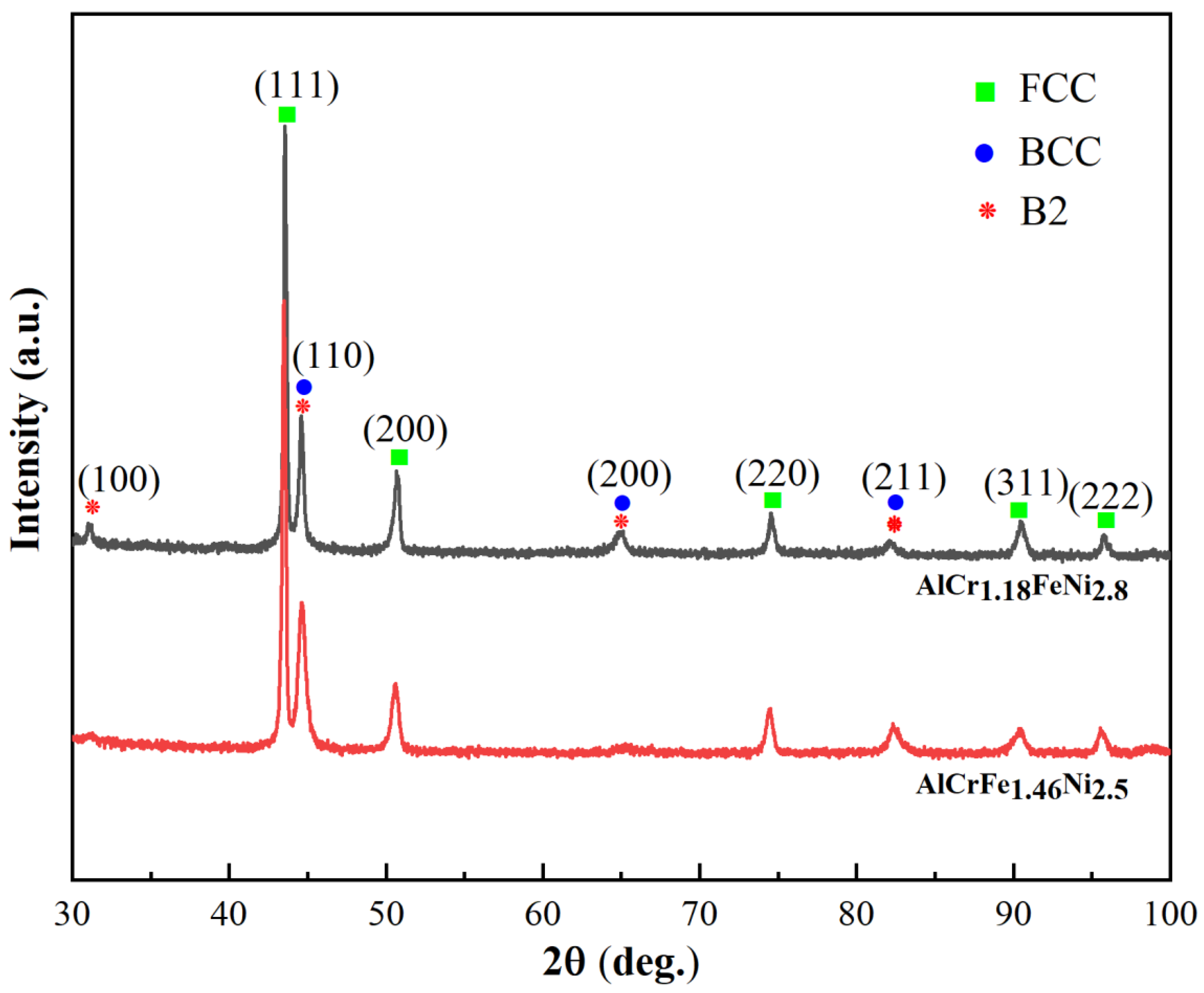
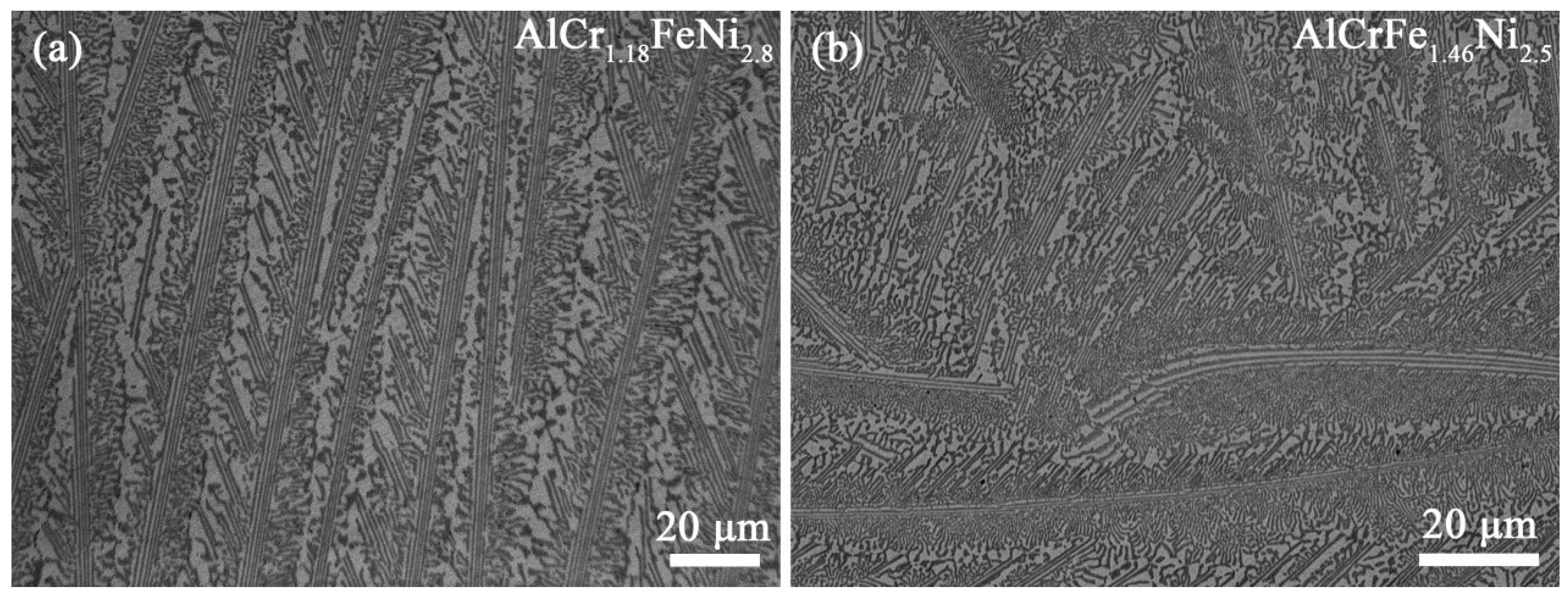
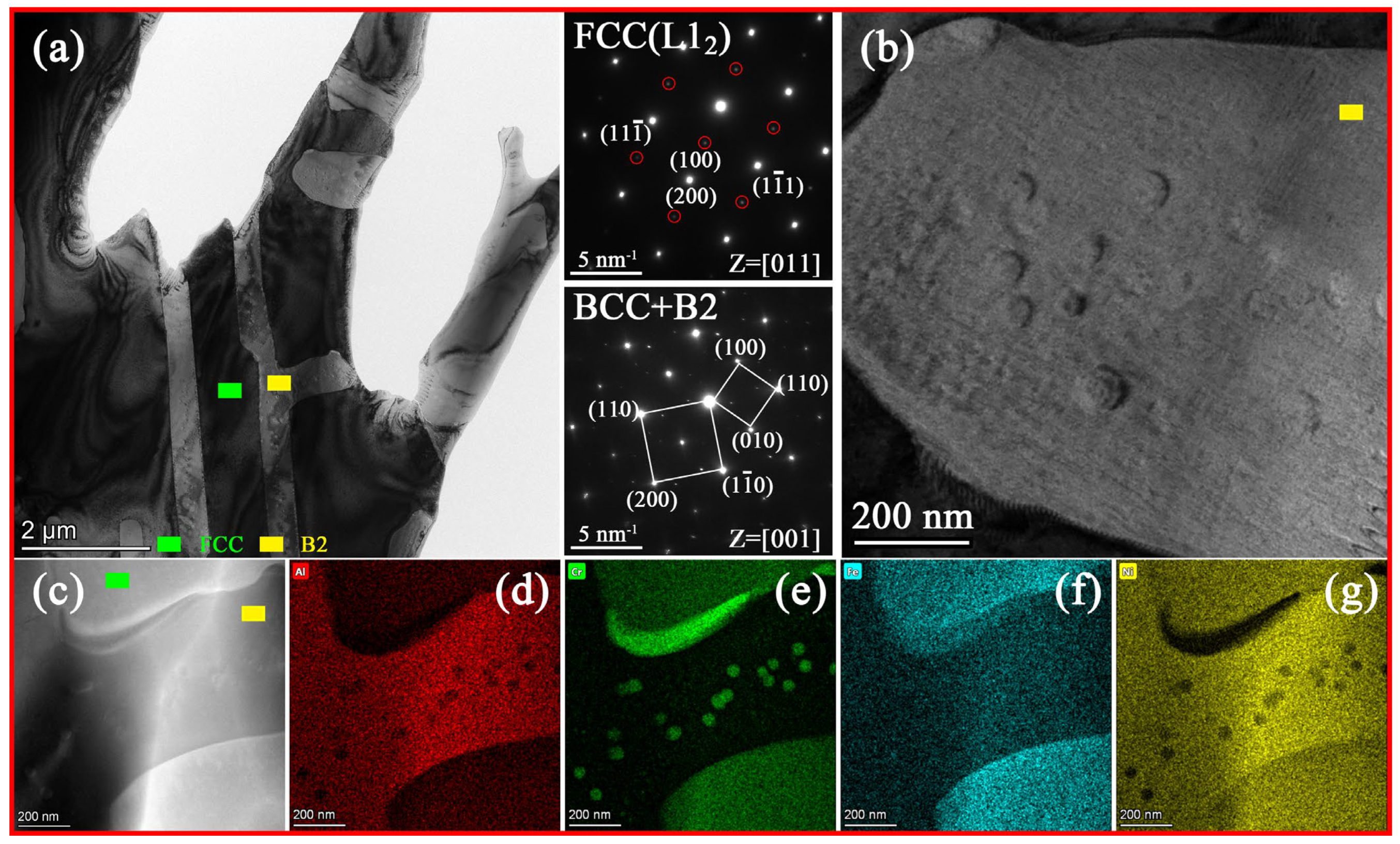
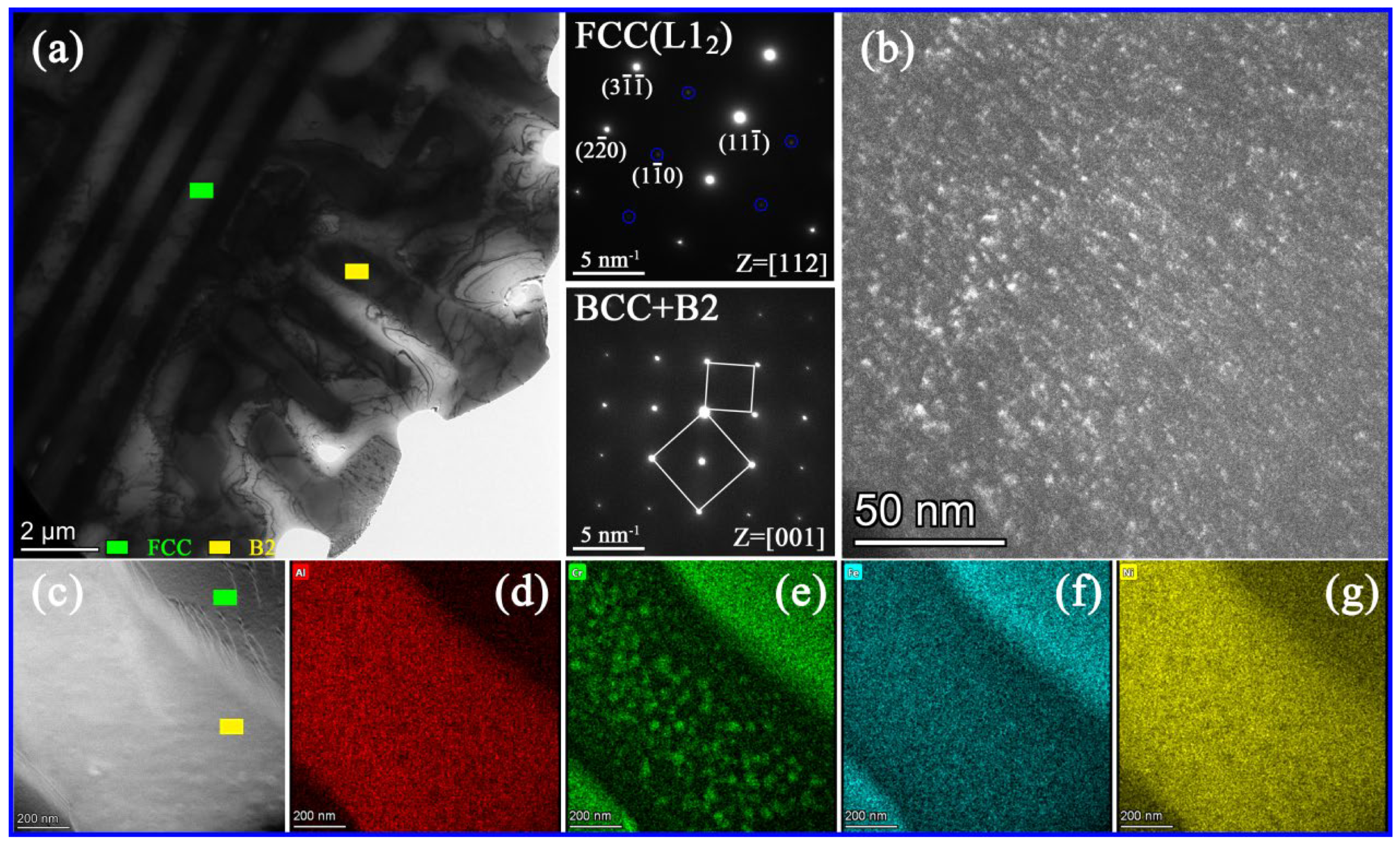
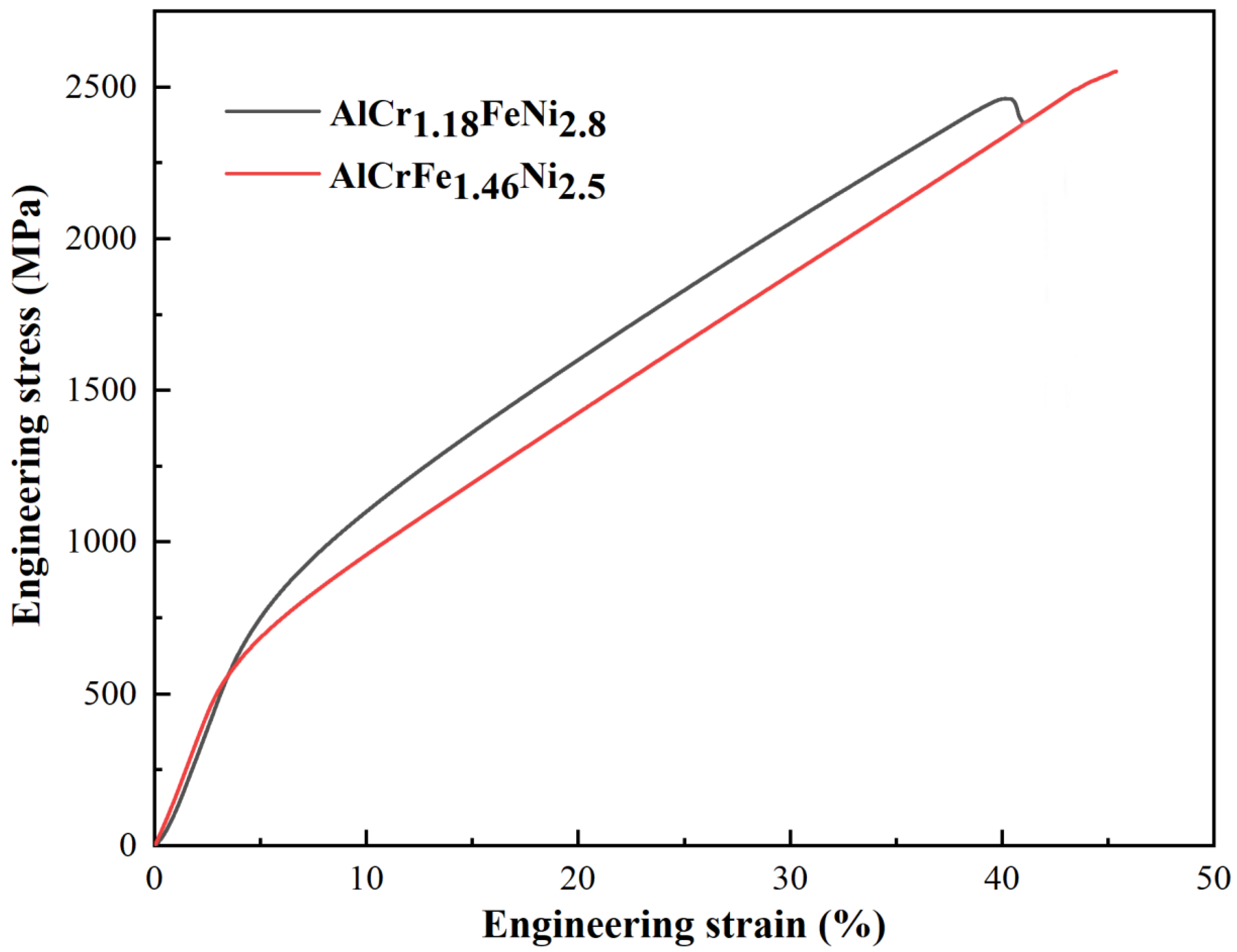
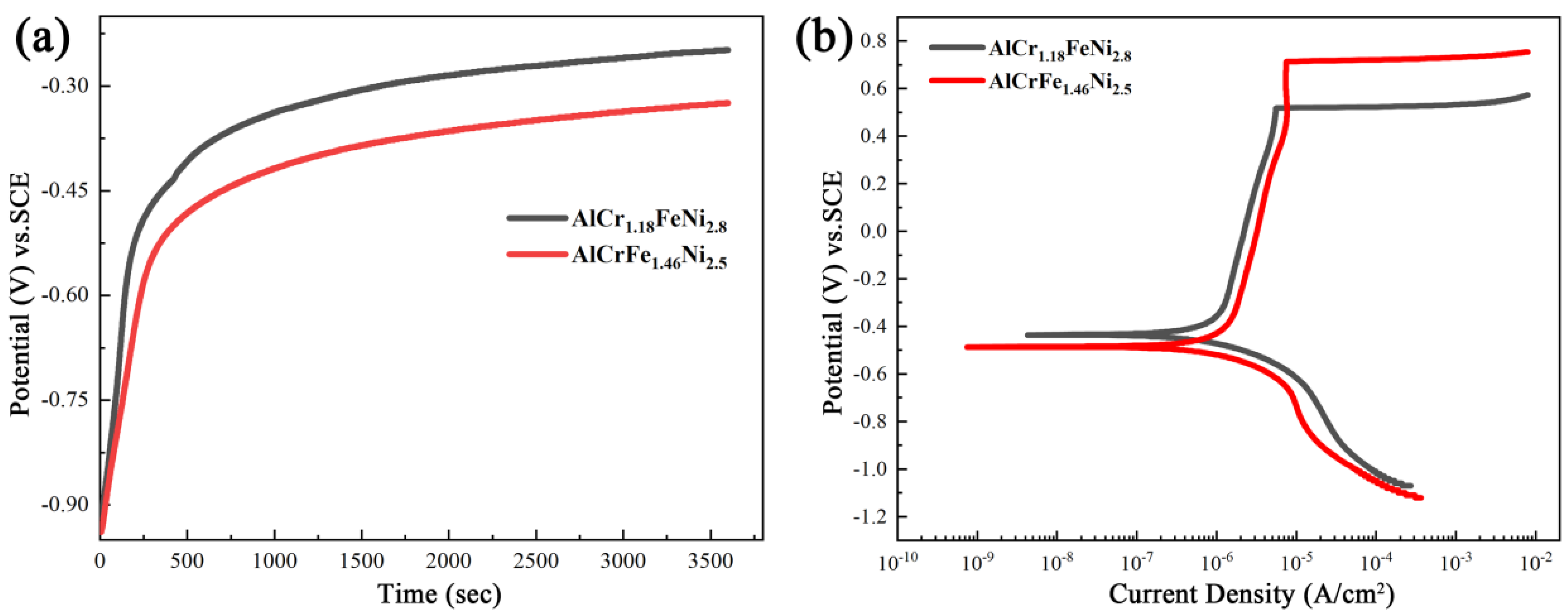
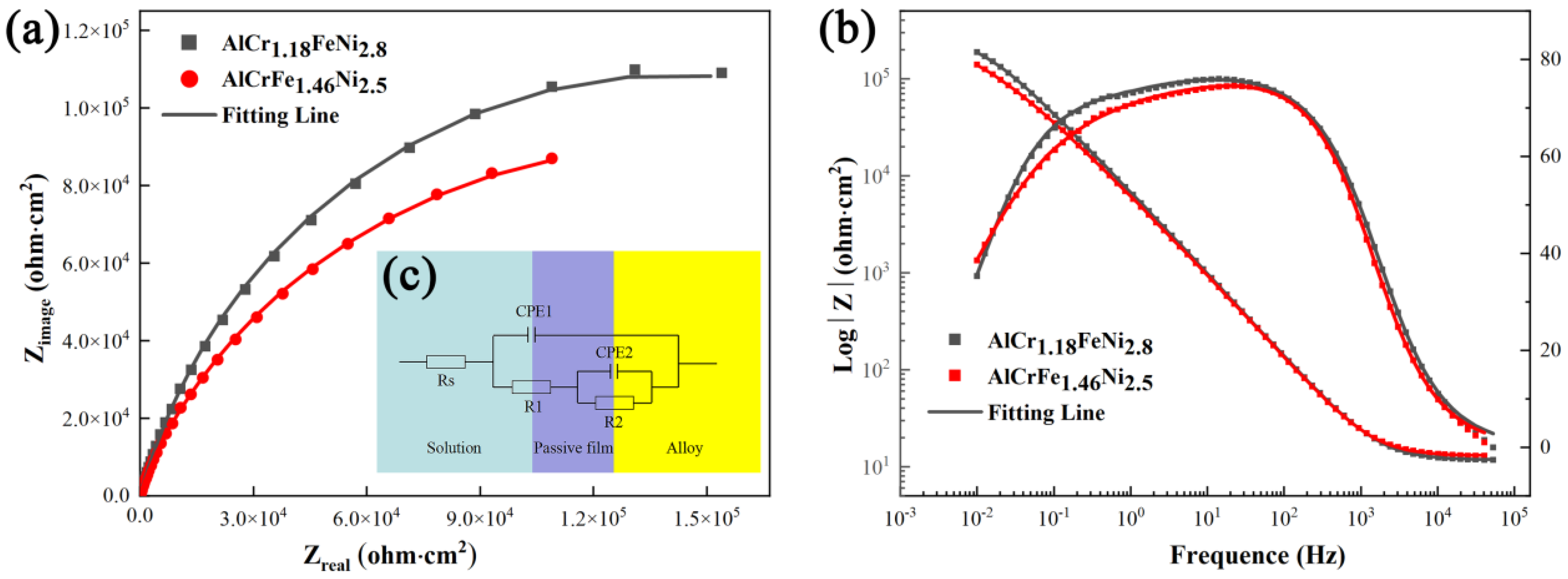
| Al | Cr | Fe | Ni | |
|---|---|---|---|---|
| Mi | 26.98 | 51.996 | 55.84 | 58.69 |
| ρi | 2.7 | 7.15 | 7.86 | 8.908 |
| (VEC)i | 3 | 6 | 8 | 10 |
| Alloy | Phase | Element (at. %) | |||
|---|---|---|---|---|---|
| Al | Cr | Fe | Ni | ||
| AlCr1.18FeNi2.8 | Nominal | 16.72 | 19.73 | 16.72 | 46.82 |
| B2 | 34.56 | 7.70 | 8.76 | 48.97 | |
| FCC | 13.17 | 24.10 | 19.67 | 43.06 | |
| AlCrFe1.46Ni2.5 | Nominal | 16.98 | 16.98 | 24.50 | 41.95 |
| B2 | 22.72 | 7.72 | 13.34 | 56.21 | |
| FCC | 8.57 | 23.54 | 32.86 | 35.03 | |
| Alloys | Yield Strength (MPa) | Fracture Strength (MPa) | Fracture Strain (%) |
|---|---|---|---|
| AlCr1.18FeNi2.8 | 516 | 2462 | 40.1 |
| AlCrFe1.46Ni2.5 | 550 | 2551 | 45.4 |
| Alloys | Ecorr (mVSCE) | Icorr (μA∙cm−2) | EP (mVSCE) | Ipass (μA∙cm−2) |
|---|---|---|---|---|
| AlCr1.18FeNi2.8 | −436 | 7.42 | 519 | 5.57 |
| AlCrFe1.46Ni2.5 | −487 | 9.25 | 713 | 7.49 |
| Alloys | Rs (Ω⋅cm2) | R1 (kΩ⋅cm2) | R2 (MΩ⋅cm2) | CPE1 (×10−5 Ω−1⋅cm2⋅Sn) | n1 | CPE2 (×10−5 Ω−1⋅cm2⋅Sn) | n2 | χ2 |
|---|---|---|---|---|---|---|---|---|
| AlCr1.18FeNi2.8 | 11.71 | 45.13 | 0.24 | 2.86 | 0.86 | 62.48 | 0.70 | 0.3 × 10−3 |
| AlCrFe1.46Ni2.5 | 12.91 | 5.05 | 0.30 | 2.76 | 0.87 | 1.29 | 0.54 | 0.1 × 10−3 |
Disclaimer/Publisher’s Note: The statements, opinions and data contained in all publications are solely those of the individual author(s) and contributor(s) and not of MDPI and/or the editor(s). MDPI and/or the editor(s) disclaim responsibility for any injury to people or property resulting from any ideas, methods, instructions or products referred to in the content. |
© 2022 by the authors. Licensee MDPI, Basel, Switzerland. This article is an open access article distributed under the terms and conditions of the Creative Commons Attribution (CC BY) license (https://creativecommons.org/licenses/by/4.0/).
Share and Cite
Yuan, J.; Yang, Y.; Duan, S.; Dong, Y.; Li, C.; Zhang, Z. Rapid Design, Microstructures, and Properties of Low-Cost Co-Free Al-Cr-Fe-Ni Eutectic Medium Entropy Alloys. Materials 2023, 16, 56. https://doi.org/10.3390/ma16010056
Yuan J, Yang Y, Duan S, Dong Y, Li C, Zhang Z. Rapid Design, Microstructures, and Properties of Low-Cost Co-Free Al-Cr-Fe-Ni Eutectic Medium Entropy Alloys. Materials. 2023; 16(1):56. https://doi.org/10.3390/ma16010056
Chicago/Turabian StyleYuan, Jiongpei, Yujing Yang, Shougang Duan, Yong Dong, Chuanqiang Li, and Zhengrong Zhang. 2023. "Rapid Design, Microstructures, and Properties of Low-Cost Co-Free Al-Cr-Fe-Ni Eutectic Medium Entropy Alloys" Materials 16, no. 1: 56. https://doi.org/10.3390/ma16010056






